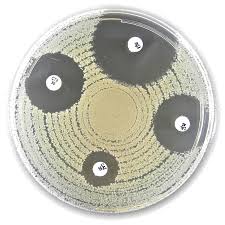Liofilchem® Cefotaxime CTX Antimicrobial Susceptibility Discs, 30 µg (copy)
Catalog No :
CAS Number :
Brand :
In Stock
Specifications:
| Application | Microbiology |
| Storage Temperature | 2-8°C |
| Product Type | Antibiotic Disc |
| Product Brand | Liofilchem |
| Product Grade | Microbiology grade |
The Liofilchem® Cefotaxime (CTX) Antimicrobial Susceptibility Discs, available in 30 µg (Cat. No. 9017) and 5 µg (Cat. No. 9152), are essential tools for in vitro antimicrobial susceptibility testing (AST). These discs help clinical laboratories evaluate bacterial resistance to cefotaxime, a third-generation cephalosporin, widely used in the treatment of Gram-negative bacterial infections.
Cefotaxime susceptibility testing is critical for detecting antibiotic resistance mechanisms, including extended-spectrum beta-lactamases (ESBLs) and AmpC beta-lactamases, guiding effective treatment decisions in infectious disease management.
Composition & Mechanism of Action
| Component | Function |
|---|---|
| Cefotaxime (CTX) (30 µg or 5 µg) | A broad-spectrum third-generation cephalosporin that inhibits bacterial cell-wall synthesis by binding to penicillin-binding proteins (PBPs), leading to bacterial cell death. |
Cefotaxime is highly active against many Gram-negative organisms, but resistance may occur due to beta-lactamase production, porin loss, or efflux mechanisms. The 30 µg and 5 µg discs allow for differential susceptibility testing, identifying low- and high-level resistance phenotypes in bacterial isolates.
Use Cases & Applications
1. Routine Antimicrobial Susceptibility Testing (AST) in Clinical Microbiology
Primary Use:
- Evaluating cefotaxime susceptibility in:
- Escherichia coli
- Klebsiella pneumoniae
- Proteus mirabilis
- Enterobacter spp.
- Citrobacter spp.
- Other Enterobacterales
Practical Example:
A hospital laboratory receives a blood culture isolate from a patient with sepsis. The isolate is tested using Liofilchem® Cefotaxime (30 µg) discs in a standard Kirby-Bauer disc diffusion test.
- A large inhibition zone indicates susceptibility, guiding the continuation of cefotaxime therapy.
- A small or absent inhibition zone suggests resistance, prompting a switch to an alternative antibiotic, such as a carbapenem or aminoglycoside.
2. Detection of Extended-Spectrum Beta-Lactamase (ESBL)-Producing Bacteria
Primary Use:
- Screening for ESBL production in Enterobacterales by comparing cefotaxime susceptibility with and without clavulanic acid (CTX+CTL discs).
Practical Example:
A urine culture from a patient with a urinary tract infection (UTI) shows reduced susceptibility to cefotaxime (30 µg disc).
- The laboratory performs an ESBL confirmatory test using Cefotaxime + Clavulanic Acid (CTX+CTL) discs.
- If there is a ≥5 mm increase in inhibition zone diameter in the presence of clavulanic acid, the isolate is confirmed as ESBL-positive.
- This result informs antibiotic selection, guiding clinicians to avoid third-generation cephalosporins and use carbapenems or alternative beta-lactamase inhibitor combinations.
3. Differentiation of Low- and High-Level Beta-Lactam Resistance
Primary Use:
- Distinguishing between different beta-lactamase-producing bacterial populations using low (5 µg) and high (30 µg) cefotaxime concentrations.
Practical Example:
A laboratory receives an isolate of Enterobacter cloacae, suspected to harbor AmpC beta-lactamases.
- Testing with Cefotaxime 30 µg (9017) and 5 µg (9152) discs shows resistance to the 5 µg disc but partial susceptibility to the 30 µg disc.
- This pattern suggests low-level AmpC expression, whereas resistance to both discs may indicate high-level AmpC or ESBL production.
- The results help guide treatment, suggesting beta-lactamase inhibitor therapy or alternative antibiotics like fluoroquinolones or aminoglycosides.
4. Surveillance & Public Health Monitoring of Antibiotic Resistance
Primary Use:
- Tracking trends in cefotaxime resistance among hospital and community-acquired infections.
- Supporting antibiotic stewardship programs by identifying patterns of resistance.
Practical Example:
A public health laboratory collects E. coli and K. pneumoniae isolates from regional hospitals to monitor third-generation cephalosporin resistance trends.
- Testing with Liofilchem® Cefotaxime 30 µg discs provides valuable epidemiological data on antimicrobial resistance (AMR) rates.
- Results inform policy changes in empirical antibiotic prescribing, contributing to better antimicrobial stewardship strategies.
Testing Procedure & Interpretation
1. Standardized Testing Protocol
- Disc Diffusion Method (Kirby-Bauer technique) following:
- Clinical and Laboratory Standards Institute (CLSI) guidelines
- European Committee on Antimicrobial Susceptibility Testing (EUCAST) guidelines
Step-by-Step Procedure:
- Prepare a bacterial suspension adjusted to 0.5 McFarland standard.
- Inoculate a Mueller-Hinton agar plate with the bacterial culture.
- Apply CTX discs (30 µg and/or 5 µg) onto the agar surface.
- Incubate the plate at 35 ± 2°C for 16–18 hours.
- Measure the inhibition zones and interpret results based on CLSI/EUCAST breakpoints.
2. Interpretation of Results
| Zone Diameter | Interpretation (CLSI/EUCAST Guidelines) |
|---|---|
| ≥26 mm | Susceptible |
| 22–25 mm | Intermediate Resistance |
| ≤21 mm | Resistant |
For low-dose (5 µg) cefotaxime discs, a smaller zone may indicate low-level resistance, while a complete lack of inhibition suggests high-level beta-lactamase production.
Key Benefits & Advantages
✅ Reliable & Standardized – Ensures accurate detection of cefotaxime resistance, following global clinical guidelines.
✅ Essential for ESBL & Beta-Lactamase Testing – Supports differentiation of resistance mechanisms in Enterobacterales.
✅ Public Health Impact – Aids in antimicrobial resistance surveillance and hospital infection control programs.
✅ User-Friendly & Cost-Effective – Provides a straightforward, culture-based alternative to molecular resistance testing.
Product Specifications & Storage
| Feature | Details |
|---|---|
| Product Codes | 9017 (30 µg), 9152 (5 µg) |
| Packaging | 250 discs per pack (cartridge format) |
| Storage Temperature | 2–8°C (Refrigerated) |
| Shelf Life | Use before expiry date for optimal performance |
The Liofilchem® Cefotaxime (CTX) Antimicrobial Susceptibility Discs (30 µg & 5 µg) are indispensable for clinical microbiology laboratories, supporting antibiotic susceptibility testing, ESBL detection, and public health surveillance. By ensuring accurate and reliable results, these discs play a crucial role in antibiotic stewardship and combating multidrug-resistant infections.
- Drug Concentration: 5 µg 30 µg




 0
0
